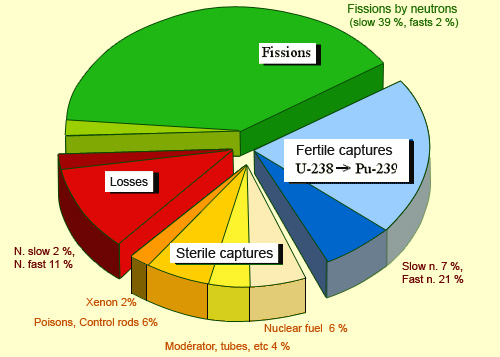What happens to fission neutrons?
Within a reactor the objective is to maintain the chain reaction of fissions constant. This means that, out of the 2 to three primary neutrons produced during a fission, at least one (neither more nor less) generates a second fission.
Fission neutrons are produced in reactors with considerable energy, around 1 to 2 million electronvolts or MeV. These neutrons are called « fast« . They will experience a high number of collisions which slow them down. If they are not captured on their way, they will become « slow » neutrons and may give birth to secondary fissions.
The energy of the neutrons that trigger the fission reaction plays an essential role in the operation of reactors, including the most common pressurized water and boiling water reactors. The probability of fission reactions varies greatly with the energy of the neutrons. Low with fast neutrons, it becomes high with slow neutrons.

Distribution of slow and fast neutrons in a PWR
This neutrons repartition in a pressurised water reactor shows the different roles played by slow and fast neutrons. Slow neutrons are responsible for most of nuclear fissions and help sustain the chain reactions. Fast neutrons, on the other hand, play a small role in fission but can transform uranium 238 nuclei into fissile plutonium 239. Other neutrons are lost when they are captured by ‘sterile’ nuclei or when they escape from the reactor as they slow down. Among these, some can poison the performance of the reactor, others are used for the control of the chain reaction (control rods).
© IN2P3
What happens to these neutrons as they slow down? Several possibilities are offered to them.
1) – A simple collision: this is the most frequent phenomenon. The collision is said to be elastic because the neutron bounces off the nucleus. This is how he loses his energy and slows down.
2) – Loss by leaks: The neutron is lost for the chain reaction because it leaves the reactor core and never returns. In a pressurized water reactor the majority of leaks occur from fast neutrons.
Apart from elastic collisions and leaks, the neutron can also be captured by a nucleus. Depending on the target nucleus and how it reacts, there are three types of captures.
3) – Sterile capture: the neutron is captured by the nuclei of the moderator, structural metals, fuel cladding, control rods or even by fissile nuclei but without giving rise to fission. These neutrons are part of the losses for the chain reaction. The structural materials are activated (made radioactive) by these captures. They must be as transparent as possible to neutrons. This is the reason for using zirconium for the cladding covering the fuel.
4) – A fertile capture: the neutron is captured by an uranium-238 nucleus which is transformed into plutonium-239. The nucleus has not undergone fission, but plutonium-239 is ready to undergo one at the next neutron it captures. Fertile captures are mainly due to fast neutrons.
5) – Fissile capture: the nucleus is captured by an uranium or plutonium nucleus which undergoes fission and generates new neutrons ready to contribute in turn to the chain reaction. While fast neutrons are able of triggering fissions, including in uranium-238, these captures by uranium-235 and plutonium-239 are mainly due to slow neutrons.
Other articles on the subject « Neutronic Radiations »
Neutron Capture
Capture competes with fission and generates radioactivity The neutron is a special elementary par[...]
Slow and fast neutrons
Fission depends on the energy of the neutrons Nuclear fission can occur when a nucleus is rendere[...]
Slow neutrons
Slow neutrons favour fission In nuclear reactors slow neutrons are neutrons slowed down after a s[...]
Fast neutrons
Fast neutrons for surgeneration and breeders Before they are slowed down by a large number of nuc[...]
Neutron Moderators
Slowing fast neutrons without capturing them The presence of a moderator; is essential for operat[...]